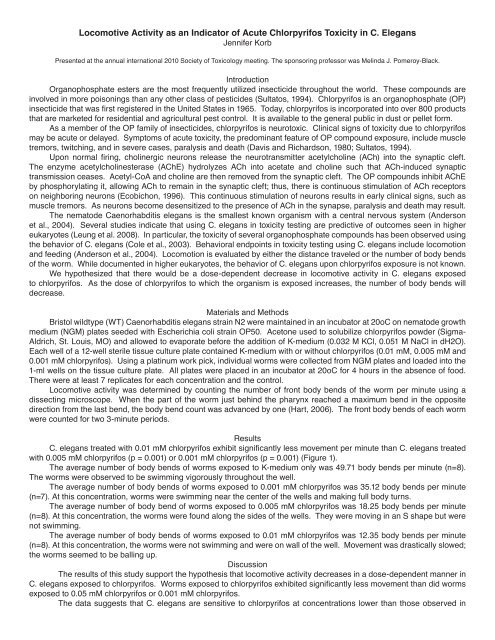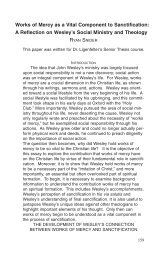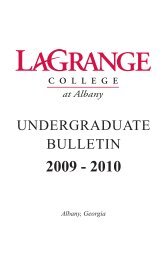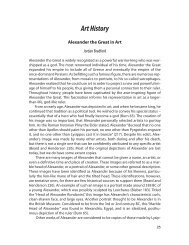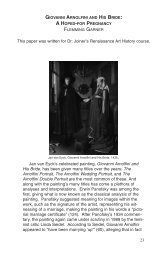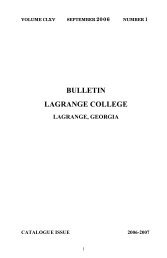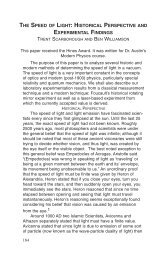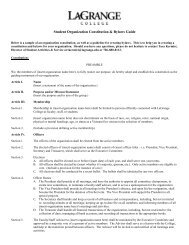Locomotive Activity as an Indicator of Acute Chlorpyrifos Toxicity in ...
Locomotive Activity as an Indicator of Acute Chlorpyrifos Toxicity in ...
Locomotive Activity as an Indicator of Acute Chlorpyrifos Toxicity in ...
You also want an ePaper? Increase the reach of your titles
YUMPU automatically turns print PDFs into web optimized ePapers that Google loves.
<strong>Locomotive</strong> <strong>Activity</strong> <strong>as</strong> <strong>an</strong> <strong>Indicator</strong> <strong>of</strong> <strong>Acute</strong> <strong>Chlorpyrifos</strong> <strong>Toxicity</strong> <strong>in</strong> C. Eleg<strong>an</strong>s<br />
Jennifer Korb<br />
Presented at the <strong>an</strong>nual <strong>in</strong>ternational 2010 Society <strong>of</strong> Toxicology meet<strong>in</strong>g. The sponsor<strong>in</strong>g pr<strong>of</strong>essor w<strong>as</strong> Mel<strong>in</strong>da J. Pomeroy-Black.<br />
Introduction<br />
Org<strong>an</strong>ophosphate esters are the most frequently utilized <strong>in</strong>secticide throughout the world. These compounds are<br />
<strong>in</strong>volved <strong>in</strong> more poison<strong>in</strong>gs th<strong>an</strong> <strong>an</strong>y other cl<strong>as</strong>s <strong>of</strong> pesticides (Sultatos, 1994). <strong>Chlorpyrifos</strong> is <strong>an</strong> org<strong>an</strong>ophosphate (OP)<br />
<strong>in</strong>secticide that w<strong>as</strong> first registered <strong>in</strong> the United States <strong>in</strong> 1965. Today, chlorpyrifos is <strong>in</strong>corporated <strong>in</strong>to over 800 products<br />
that are marketed for residential <strong>an</strong>d agricultural pest control. It is available to the general public <strong>in</strong> dust or pellet form.<br />
As a member <strong>of</strong> the OP family <strong>of</strong> <strong>in</strong>secticides, chlorpyrifos is neurotoxic. Cl<strong>in</strong>ical signs <strong>of</strong> toxicity due to chlorpyrifos<br />
may be acute or delayed. Symptoms <strong>of</strong> acute toxicity, the predom<strong>in</strong><strong>an</strong>t feature <strong>of</strong> OP compound exposure, <strong>in</strong>clude muscle<br />
tremors, twitch<strong>in</strong>g, <strong>an</strong>d <strong>in</strong> severe c<strong>as</strong>es, paralysis <strong>an</strong>d death (Davis <strong>an</strong>d Richardson, 1980; Sultatos, 1994).<br />
Upon normal fir<strong>in</strong>g, chol<strong>in</strong>ergic neurons rele<strong>as</strong>e the neurotr<strong>an</strong>smitter acetylchol<strong>in</strong>e (ACh) <strong>in</strong>to the synaptic cleft.<br />
The enzyme acetylchol<strong>in</strong>ester<strong>as</strong>e (AChE) hydrolyzes ACh <strong>in</strong>to acetate <strong>an</strong>d chol<strong>in</strong>e such that ACh-<strong>in</strong>duced synaptic<br />
tr<strong>an</strong>smission ce<strong>as</strong>es. Acetyl-CoA <strong>an</strong>d chol<strong>in</strong>e are then removed from the synaptic cleft. The OP compounds <strong>in</strong>hibit AChE<br />
by phosphorylat<strong>in</strong>g it, allow<strong>in</strong>g ACh to rema<strong>in</strong> <strong>in</strong> the synaptic cleft; thus, there is cont<strong>in</strong>uous stimulation <strong>of</strong> ACh receptors<br />
on neighbor<strong>in</strong>g neurons (Ecobichon, 1996). This cont<strong>in</strong>uous stimulation <strong>of</strong> neurons results <strong>in</strong> early cl<strong>in</strong>ical signs, such <strong>as</strong><br />
muscle tremors. As neurons become desensitized to the presence <strong>of</strong> ACh <strong>in</strong> the synapse, paralysis <strong>an</strong>d death may result.<br />
The nematode Caenorhabditis eleg<strong>an</strong>s is the smallest known org<strong>an</strong>ism with a central nervous system (Anderson<br />
et al., 2004). Several studies <strong>in</strong>dicate that us<strong>in</strong>g C. eleg<strong>an</strong>s <strong>in</strong> toxicity test<strong>in</strong>g are predictive <strong>of</strong> outcomes seen <strong>in</strong> higher<br />
eukaryotes (Leung et al. 2008). In particular, the toxicity <strong>of</strong> several org<strong>an</strong>ophosphate compounds h<strong>as</strong> been observed us<strong>in</strong>g<br />
the behavior <strong>of</strong> C. eleg<strong>an</strong>s (Cole et al., 2003). Behavioral endpo<strong>in</strong>ts <strong>in</strong> toxicity test<strong>in</strong>g us<strong>in</strong>g C. eleg<strong>an</strong>s <strong>in</strong>clude locomotion<br />
<strong>an</strong>d feed<strong>in</strong>g (Anderson et al., 2004). Locomotion is evaluated by either the dist<strong>an</strong>ce traveled or the number <strong>of</strong> body bends<br />
<strong>of</strong> the worm. While documented <strong>in</strong> higher eukaryotes, the behavior <strong>of</strong> C. eleg<strong>an</strong>s upon chlorpyrifos exposure is not known.<br />
We hypothesized that there would be a dose-dependent decre<strong>as</strong>e <strong>in</strong> locomotive activity <strong>in</strong> C. eleg<strong>an</strong>s exposed<br />
to chlorpyrifos. As the dose <strong>of</strong> chlorpyrifos to which the org<strong>an</strong>ism is exposed <strong>in</strong>cre<strong>as</strong>es, the number <strong>of</strong> body bends will<br />
decre<strong>as</strong>e.<br />
Materials <strong>an</strong>d Methods<br />
Bristol wildtype (WT) Caenorhabditis eleg<strong>an</strong>s stra<strong>in</strong> N2 were ma<strong>in</strong>ta<strong>in</strong>ed <strong>in</strong> <strong>an</strong> <strong>in</strong>cubator at 20oC on nematode growth<br />
medium (NGM) plates seeded with Escherichia coli stra<strong>in</strong> OP50. Acetone used to solubilize chlorpyrifos powder (Sigma-<br />
Aldrich, St. Louis, MO) <strong>an</strong>d allowed to evaporate before the addition <strong>of</strong> K-medium (0.032 M KCl, 0.051 M NaCl <strong>in</strong> dH2O).<br />
Each well <strong>of</strong> a 12-well sterile tissue culture plate conta<strong>in</strong>ed K-medium with or without chlorpyrifos (0.01 mM, 0.005 mM <strong>an</strong>d<br />
0.001 mM chlorpyrifos). Us<strong>in</strong>g a plat<strong>in</strong>um work pick, <strong>in</strong>dividual worms were collected from NGM plates <strong>an</strong>d loaded <strong>in</strong>to the<br />
1-ml wells on the tissue culture plate. All plates were placed <strong>in</strong> <strong>an</strong> <strong>in</strong>cubator at 20oC for 4 hours <strong>in</strong> the absence <strong>of</strong> food.<br />
There were at le<strong>as</strong>t 7 replicates for each concentration <strong>an</strong>d the control.<br />
<strong>Locomotive</strong> activity w<strong>as</strong> determ<strong>in</strong>ed by count<strong>in</strong>g the number <strong>of</strong> front body bends <strong>of</strong> the worm per m<strong>in</strong>ute us<strong>in</strong>g a<br />
dissect<strong>in</strong>g microscope. When the part <strong>of</strong> the worm just beh<strong>in</strong>d the pharynx reached a maximum bend <strong>in</strong> the opposite<br />
direction from the l<strong>as</strong>t bend, the body bend count w<strong>as</strong> adv<strong>an</strong>ced by one (Hart, 2006). The front body bends <strong>of</strong> each worm<br />
were counted for two 3-m<strong>in</strong>ute periods.<br />
Results<br />
C. eleg<strong>an</strong>s treated with 0.01 mM chlorpyrifos exhibit signific<strong>an</strong>tly less movement per m<strong>in</strong>ute th<strong>an</strong> C. eleg<strong>an</strong>s treated<br />
with 0.005 mM chlorpyrifos (p = 0.001) or 0.001 mM chlorpyrifos (p = 0.001) (Figure 1).<br />
The average number <strong>of</strong> body bends <strong>of</strong> worms exposed to K-medium only w<strong>as</strong> 49.71 body bends per m<strong>in</strong>ute (n=8).<br />
The worms were observed to be swimm<strong>in</strong>g vigorously throughout the well.<br />
The average number <strong>of</strong> body bends <strong>of</strong> worms exposed to 0.001 mM chlorpyrifos w<strong>as</strong> 35.12 body bends per m<strong>in</strong>ute<br />
(n=7). At this concentration, worms were swimm<strong>in</strong>g near the center <strong>of</strong> the wells <strong>an</strong>d mak<strong>in</strong>g full body turns.<br />
The average number <strong>of</strong> body bend <strong>of</strong> worms exposed to 0.005 mM chlorpyrifos w<strong>as</strong> 18.25 body bends per m<strong>in</strong>ute<br />
(n=8). At this concentration, the worms were found along the sides <strong>of</strong> the wells. They were mov<strong>in</strong>g <strong>in</strong> <strong>an</strong> S shape but were<br />
not swimm<strong>in</strong>g.<br />
The average number <strong>of</strong> body bends <strong>of</strong> worms exposed to 0.01 mM chlorpyrifos w<strong>as</strong> 12.35 body bends per m<strong>in</strong>ute<br />
(n=8). At this concentration, the worms were not swimm<strong>in</strong>g <strong>an</strong>d were on wall <strong>of</strong> the well. Movement w<strong>as</strong> dr<strong>as</strong>tically slowed;<br />
the worms seemed to be ball<strong>in</strong>g up.<br />
Discussion<br />
The results <strong>of</strong> this study support the hypothesis that locomotive activity decre<strong>as</strong>es <strong>in</strong> a dose-dependent m<strong>an</strong>ner <strong>in</strong><br />
C. eleg<strong>an</strong>s exposed to chlorpyrifos. Worms exposed to chlorpyrifos exhibited signific<strong>an</strong>tly less movement th<strong>an</strong> did worms<br />
exposed to 0.05 mM chlorpyrifos or 0.001 mM chlorpyrifos.<br />
The data suggests that C. eleg<strong>an</strong>s are sensitive to chlorpyrifos at concentrations lower th<strong>an</strong> those observed <strong>in</strong>
other <strong>an</strong>imal models, <strong>in</strong>clud<strong>in</strong>g mammals <strong>an</strong>d hens. It is more typical that <strong>in</strong> order to mimic the toxic<strong>an</strong>t-<strong>in</strong>duced behavior<br />
<strong>of</strong> higher eukaryotes, one must use higher concentrations <strong>of</strong> the toxic<strong>an</strong>t <strong>in</strong> C. eleg<strong>an</strong>s (Cole et al., 2003). It may be<br />
that C. eleg<strong>an</strong>s are particularly susceptible to the effects <strong>of</strong> chlorpyrifos, perhaps because the compound penetrates<br />
the exoskeleton <strong>of</strong> the C. eleg<strong>an</strong>s more effectively th<strong>an</strong> other toxic<strong>an</strong>ts. Further studies alter<strong>in</strong>g the concentration <strong>of</strong><br />
chlorpyrifos to which C. eleg<strong>an</strong>s are exposed may yield <strong>an</strong> EC50 <strong>of</strong> the toxic<strong>an</strong>t such that <strong>an</strong>alysis <strong>of</strong> prote<strong>in</strong>s affected upon<br />
chlorpyrifos exposure c<strong>an</strong> be performed.<br />
Literature Cited<br />
Anderson, GL, RD Cole, <strong>an</strong>d PL Williams (2004). Assess<strong>in</strong>g behavioral toxicity with Caenorhabditis eleg<strong>an</strong>s. Environ<br />
Toxicol Chem 23(5): 1235-1240.<br />
Cole, RD, GL Anderson <strong>an</strong>d PL Williams (2003). The nematode Caenorhabditis eleg<strong>an</strong>s <strong>as</strong> a model <strong>of</strong> org<strong>an</strong>ophosphate<strong>in</strong>duced<br />
mammali<strong>an</strong> neurotoxicity. Toxicol Appl Pharmacol 194: 248-256.<br />
Davis, D <strong>an</strong>d R Richardson (1980). Org<strong>an</strong>ophosphorous compounds. In: Experimental <strong>an</strong>d Cl<strong>in</strong>ical Neurotoxicology. Eds:<br />
P. Spencer <strong>an</strong>d H. Schaumburg, Williams <strong>an</strong>d Wilk<strong>in</strong>s, Baltimore, pp. 527-544.<br />
Ecobichon, D (1996). Toxic effect <strong>of</strong> pesticides. In: C<strong>as</strong>arett <strong>an</strong>d Doull’s Toxicology: the b<strong>as</strong>ic science <strong>of</strong> poisons. Ed.: C.<br />
Kla<strong>as</strong>sen. McGraw-Hill, New York, pp. 643-689.<br />
Hart, Anne C, ed. Behavior (July 3, 2006), WormBook, ed. The C. eleg<strong>an</strong>s Research Community, WormBook, doi/10.1895/<br />
wormbook.1.87.1, http://www.wormbook.org.<br />
Leung, MCK, PL Williams, A Benedetto, C Au, KJ Helmcke, M Aschner <strong>an</strong>d JN Meyer (2008). Caenorhabditis eleg<strong>an</strong>s: An<br />
Emerg<strong>in</strong>g Model <strong>in</strong> Biomedical <strong>an</strong>d Environmental Toxicology. Tox Sci 106(1): 5-28.<br />
Sultatos, L (1994). Mammali<strong>an</strong> toxicology <strong>of</strong> org<strong>an</strong>ophosphorous pesticides. J Toxicol Environ Health 43: 271-289.<br />
80 <br />
70 <br />
0.001 mM <br />
% control<br />
60 <br />
50 <br />
40 <br />
30 <br />
20 <br />
*<br />
*<br />
0.005 mM <br />
0.01 mM <br />
10 <br />
0 <br />
chlorpyrifos concentration (mM)<br />
C. eleg<strong>an</strong>s treated with 0.01 mM chlorpyrifos exhibited signific<strong>an</strong>tly less movement per m<strong>in</strong>ute th<strong>an</strong> C. eleg<strong>an</strong>s treated with<br />
0.005 mM chlorpyrifos (p = 0.001) or 0.001 mM chlorpyrifos (p = 0.001).


